food insecurity
At ‘Garbage Cafes,’ You Can Trade Plastic Bottles for Free Food
Every morning, Akash, a 28-year-old living in Delhi, ventures out to collect plastic in order to feed his family of four.
He usually starts his day by scavenging for plastic bottles in and around the waste collection areas of different neighborhoods. He begins around 7am, when the waste from nearby houses typically arrives. His aim: to gather around three kilograms of plastic, which is enough to secure his meals for the day.
Each item he collects feels like a small victory, he says, adding up to a “bag of treasures” that he can exchange for food at what’s known as a “garbage cafe.” All three meals of the day, not only for him but for his whole family, are taken care of by these cafes across the city.
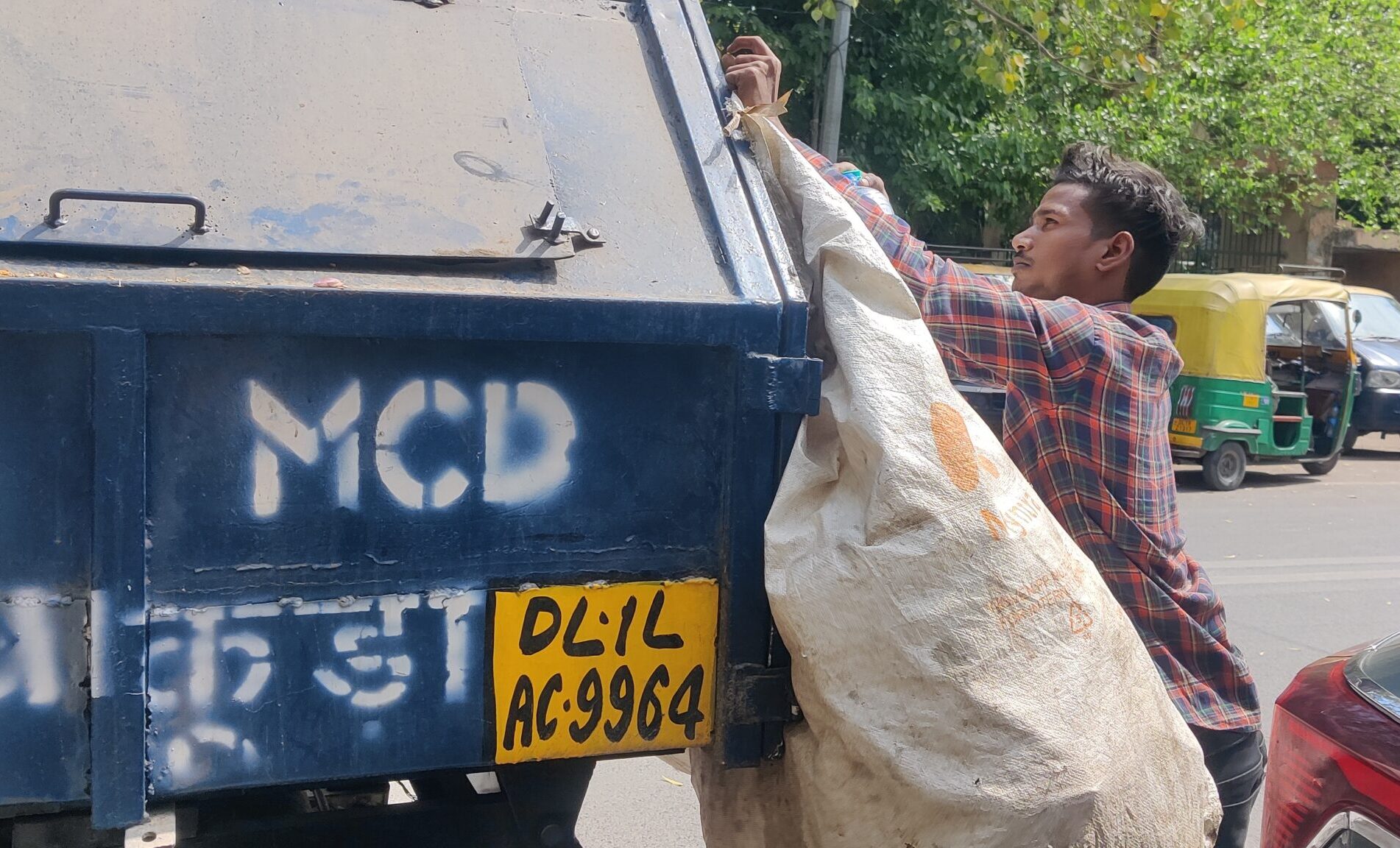 Akash often spends his day looking out for plastic bottles in the city. Credit: Rishabh Jain
Akash often spends his day looking out for plastic bottles in the city. Credit: Rishabh Jain
In a bid to preserve the environment and increase awareness about safe disposal of plastic waste, the Municipal Corporation of Delhi (MCD) came up with the concept of garbage cafes in 2020. Under this initiative, individuals who drop off one kilogram of plastic waste at designated garbage cafes receive a voucher for a complimentary meal at participating restaurants. (One kilogram can be exchanged for lunch or dinner, while just 250 grams can be exchanged for breakfast.) Eligible plastic waste includes empty water bottles, soft drink bottles, plastic containers and similar materials.
The aim is to encourage the gathering of waste while also managing the use of disposable plastic products. Eateries hand over the plastic they collect to a municipal organization, which then recycles and repurposes it.
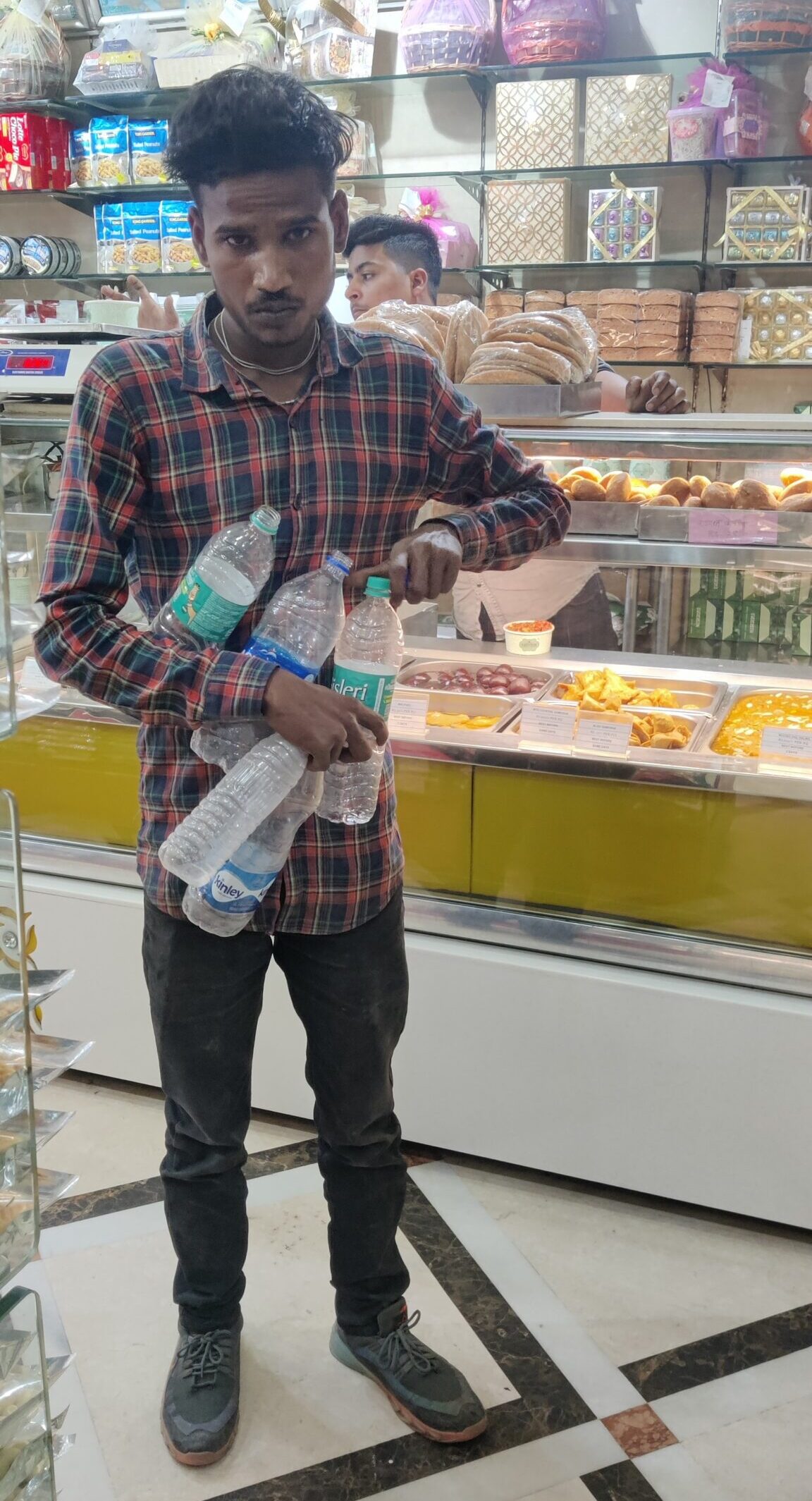 “This has really made my life easier,” says Akash. Credit: Rishabh Jain
“This has really made my life easier,” says Akash. Credit: Rishabh Jain
For Akash and many others, the cafes have been life-changing. “I came to Delhi around three years ago and started living with my relatives here,” Akash says. “While looking for a job I came across this scheme of the government where we can exchange plastic for free meals. This has really made my life easier, as I not only earn money out of selling plastic but also get free meals for my entire family.”
Business owners have seen benefits too, both environmentally and economically. Yash Kumar owns Evergreen Cafe in South Delhi. In the short time since his business was designated a garbage cafe, he says he has already seen the way the initiative has made people aware of the importance of safely disposing of plastic waste so that it gets recycled and reused, rather than ending up in landfills.
“I have seen an active participation by the people,” says Kumar, who notes that about 20 people have come to the cafe to ask about the program. “The authorities have also installed a plastic crusher machine right outside where the plastic gets safely [broken down]. We not only provide food and refreshments to people but also educate them about recycling plastic waste.”
Pointing at a pile of garbage just outside the shopping complex, predominantly consisting of plastic waste, Yash expresses that his decision to participate in this program was primarily driven by the desire to contribute positively to the city, though he also appreciates that it provides publicity for his cafe.
Mahesh, who works at Evergreen Cafe, adds that the MCD has also put up a banner outside their shop in order to spread awareness.
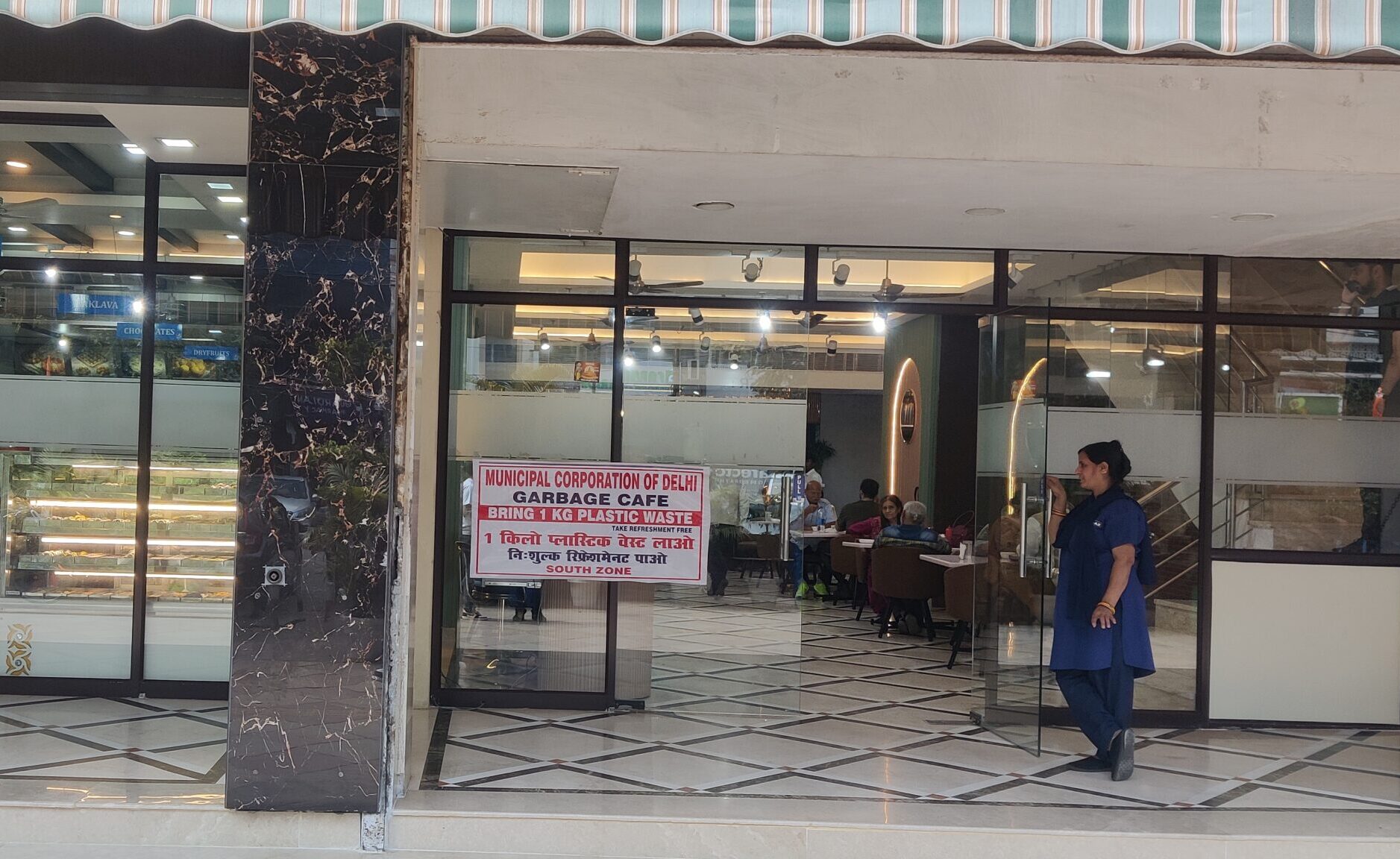 The Municipal Corporation of Delhi came up with the concept of garbage cafes in 2020. Credit: Rishabh Jain
The Municipal Corporation of Delhi came up with the concept of garbage cafes in 2020. Credit: Rishabh Jain
“People observe the banner, inquire about the process, and then come back with plastic bottles,” he says. “A significant number of them are motivated not by discounts but by the desire to make a contribution, which further motivates us. With increased publicity, we are confident that more individuals will join our cause.”
Tackling plastic pollution in Delhi
The capital city houses a population of 20 million and generates approximately 11,000 metric tons of municipal solid waste daily, the highest among Indian cities. According to government data, more than half of this waste is deposited in landfills.
Roughly 70 percent of the city’s plastic waste consists of single-use items, the majority of which either accumulate in landfills or obstruct drainage systems. This poses a significant threat to hungry cows, as they often scavenge through garbage bins, consuming plastic inadvertently.
Additionally, treatment capacity has not kept up with the volume of sewage the city produces, a trend observed not only in Delhi but also across the country. Experts suggest that raising awareness about waste sorting and expanding treatment capacity could be instrumental in addressing these challenges.
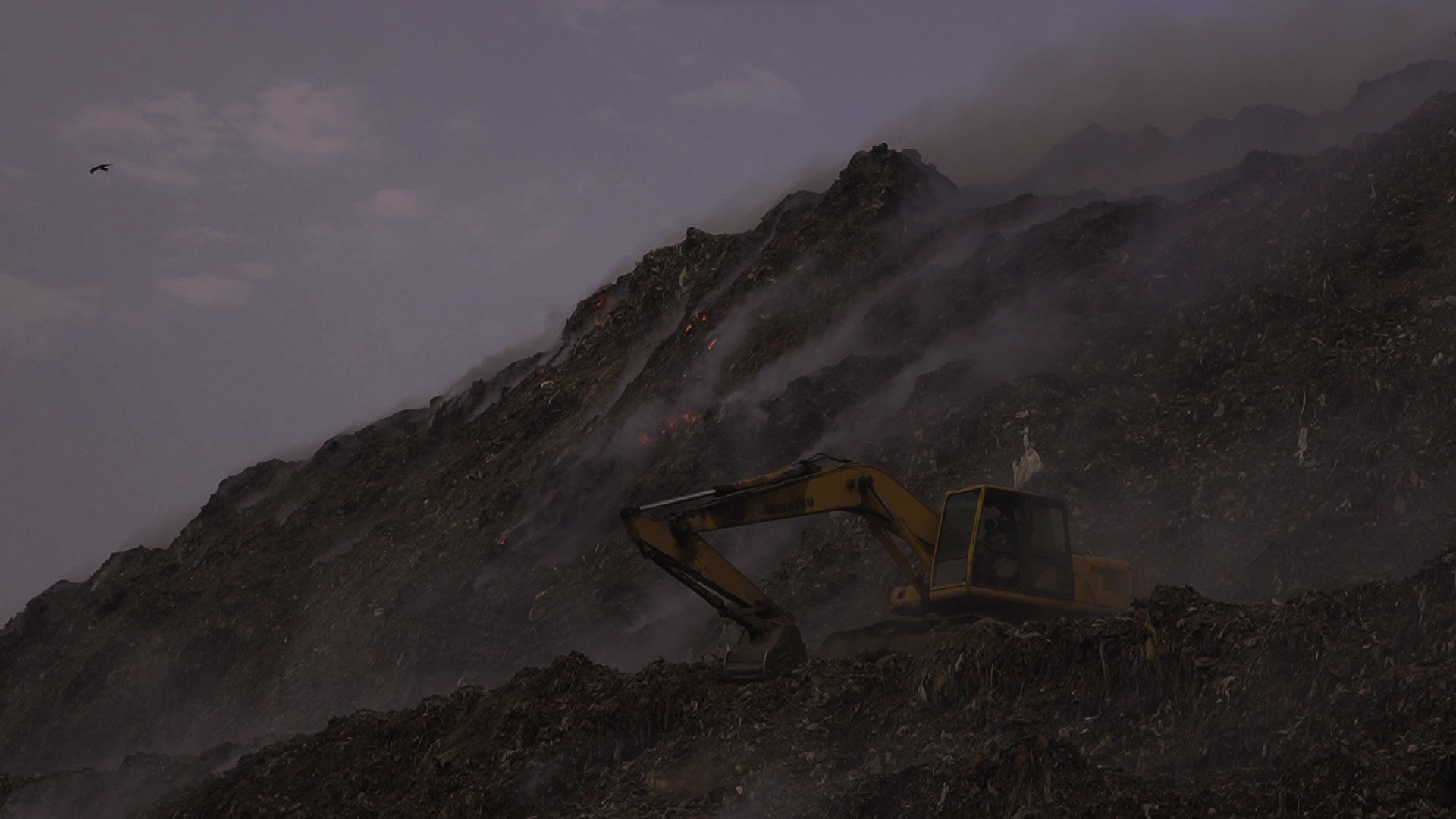 A landfill site in Delhi, where garbage often ends up burning and polluting the environment. Credit: Rishabh Jain
A landfill site in Delhi, where garbage often ends up burning and polluting the environment. Credit: Rishabh Jain
In another attempt to address the city’s plastic waste problem, the Delhi Pollution Control Committee introduced a prohibition on plastic bags smaller than 50 microns in 2015. Heavy fines have made the ban’s enforcement effective.
Efforts to reduce single-use plastic received a significant endorsement in 2019, when India’s Prime Minister Narendra Modi used the occasion of the 150th anniversary of Mahatma Gandhi’s birth to declare India’s commitment to phasing them out, though he fell short of implementing a complete ban. Since then, the country has made progress by banning certain varieties as well as by promoting reusable packaging in the food sector, which has historically been heavily reliant on plastic.
A unique initiative
The first garbage cafe opened in Chhattisgarh, a state in the central part of India, in October 2019. Places in other parts of the country picked up the trend once they saw how successful it was. Similar initiatives also exist in a variety of other countries, including in Europe, the US and Cambodia, among others.
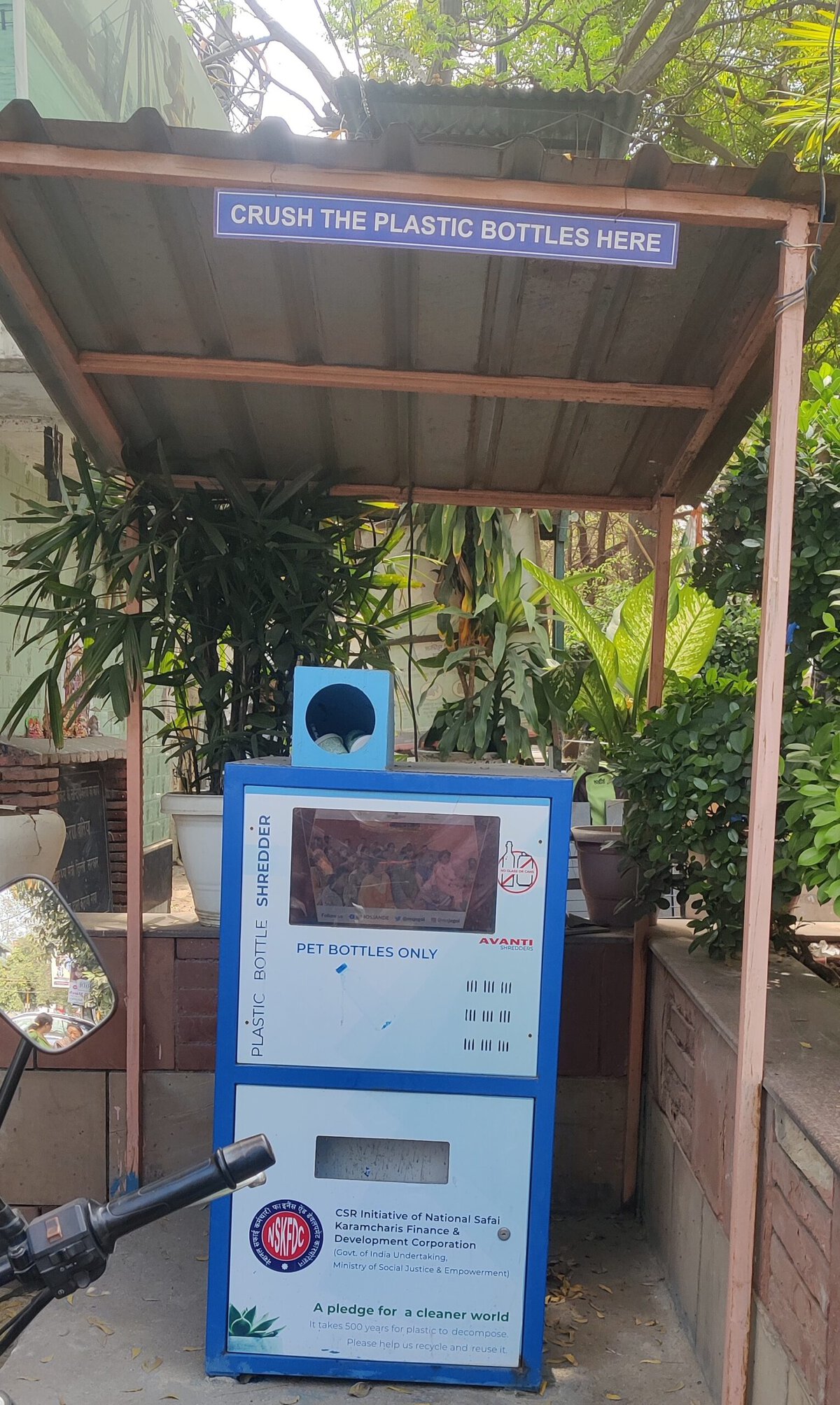 A plastic crusher machine set up outside a garbage cafe. Credit: Rishabh Jain
A plastic crusher machine set up outside a garbage cafe. Credit: Rishabh Jain
Plastic collection efforts across India reflect a growing commitment to sustainability. In Siliguri, West Bengal, alumni of a local school are offering free meals on Saturdays to individuals who contribute half a kilo of plastic waste. Similarly, in Mulugu, Telangana state, authorities provide one kilo of rice in exchange for one kilo of plastic, with local school children actively involved in plastic collection efforts. The district collector of Mulugu aims to make his district the first in India to eliminate single-use plastic. A local couple even sent out wedding invitations printed on reusable cloth grocery bags.
While celebrating the opening of a garbage cafe in South Delhi, a municipal official said, “The garbage cafe concept has been successfully implemented by local governments in Chhattisgarh and Odisha, where it aids homeless individuals by offering them complimentary meals in return for plastic waste. In Delhi, however, our approach differs in that we aim to extend this initiative to everyone. We believe that by engaging urban residents in plastic waste management efforts, we can enhance its effectiveness.”
He added that the plastic waste collected at such cafes could be used in road construction or repurposed in gardens. In Delhi, for example, a Waste-to-Wonder park showcases replicas of the seven wonders of the world, all made from discarded materials sourced from landfills.


Become a sustaining member today!
Join the Reasons to be Cheerful community by supporting our nonprofit publication and giving what you can.
Benu Malhotra, one of the trustees of Parvaah, a nonprofit organization in New Delhi advocating against plastic usage, sees the garbage cafe as a model that should be replicated nationwide. She believes that the concept is making people from all walks of life aware of the harmful effects of plastic on the environment and also guiding them on how to effectively reuse and recycle it.
She points out that garbage cafes create a kind of virtuous cycle: “This cafe addresses waste management while also providing a warm meal to those in need, thereby incentivizing them to collect more plastic.”
The post At ‘Garbage Cafes,’ You Can Trade Plastic Bottles for Free Food appeared first on Reasons to be Cheerful.
How Unfamiliar Fish Are Helping Mainers Fight Food Insecurity
As a fisherman in Maine’s groundfish industry, Geordie King is used to uncertainty: Once your net is cast, you never know what it will haul up when it returns, if it returns at all. This unpredictability holds true in general when it comes to the sea, which swayed King’s 49-foot, teal-hulled gillnetter, the Brittany Lynn, in gentle rolls as we sat in her wheelhouse, the boat’s engine idling beneath our feet. But even for King — who, after fishing in the Gulf of Maine for 40 years, was used to his work being affected by the volatility of innumerable factors — the abruptness with which the pandemic upended the fishing industry was remarkable.
“It pretty much came to a dead stop for several months,” King remembered, his eyes searching somewhere beyond the wheelhouse’s window, where the water of Casco Bay sparkled in the tilted winter sun. “The markets momentarily dried up, trucking dried up … the whole infrastructure came to a grinding halt. So that basically put a stop to fishing.”
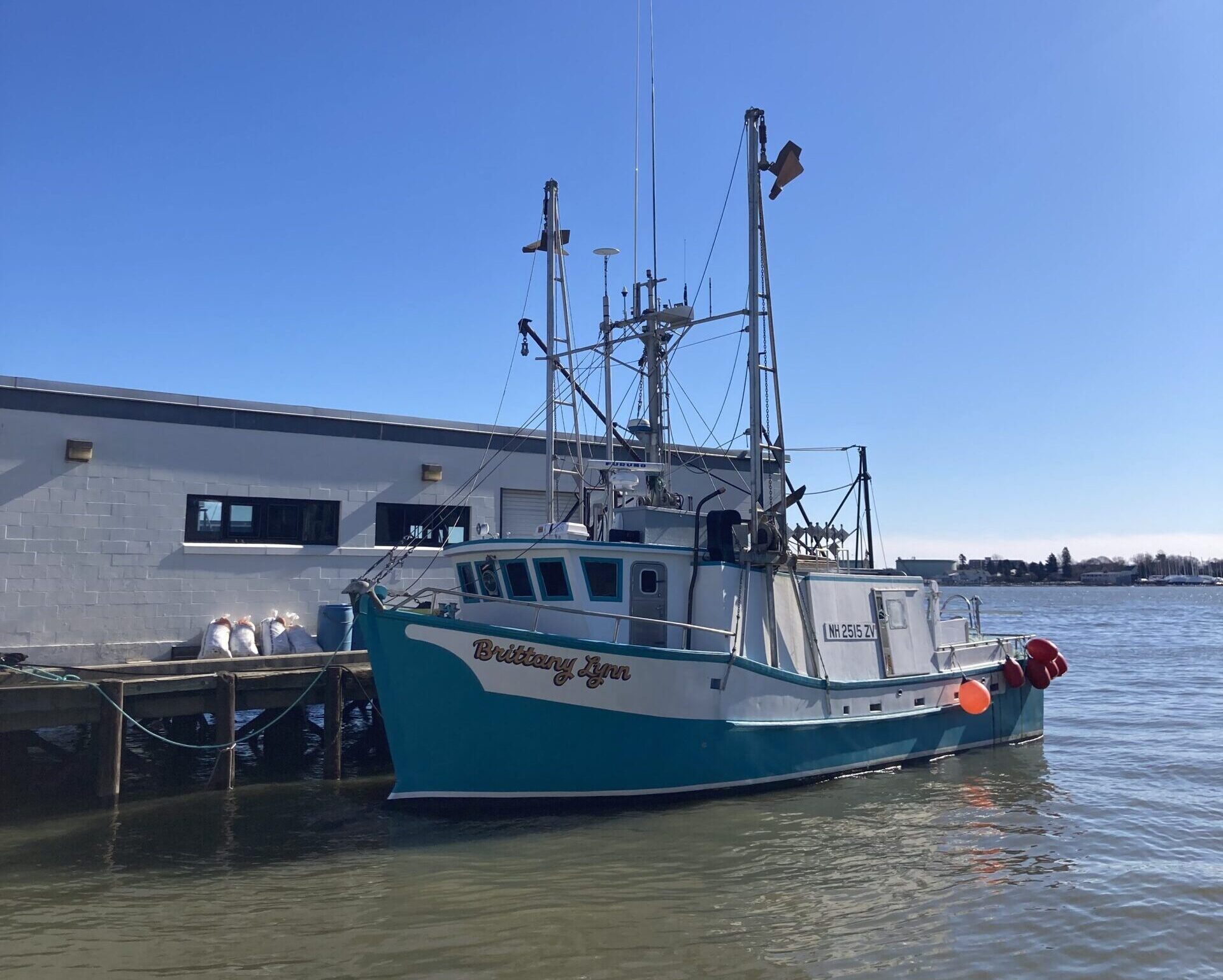 Geordie King, owner of the Brittany Lynn, has been fishing in the Gulf of Maine for 40 years. Credit: Kea Krause
Geordie King, owner of the Brittany Lynn, has been fishing in the Gulf of Maine for 40 years. Credit: Kea Krause
It wasn’t the fishing itself that was the problem. In fact, many boats were able to safely resume operations within the first year of the pandemic — the coastal breeze supplied adequate air circulation; the open ocean, with no land in sight, provided ample social distancing. But as Susan Olcott, the director of operations of the nonprofit Maine Coast Fishermen’s Association (MCFA), lays out, just about every other aspect of the industry was in crisis. Fishermen “didn’t have a market for their catch. Restaurants were closed and overseas markets were not happening,” Olcott explains. “It was not profitable for people to keep fishing.”
When the pandemic struck, MCFA had already been supporting Maine’s fishermen and working waterfronts for 15 years. And as Olcott, along with Ben Martens, MCFA’s executive director, witnessed the pandemic’s havoc on the community, the nonprofit launched a program called Fishermen Feeding Mainers (FFM) to help out people like King as they navigated the unfolding disaster. Using federal Covid relief funding, FFM purchased fish at the Portland Fish Exchange from groundfish captains, which guaranteed competitive prices. By investing in their fish, FFM enabled fishermen to return to work, confident that they would receive fair pay for their catch. In turn, FFM would make good use of the fish: by donating it to local food banks and the food programs of public school districts.
Credit: Kea Krause
Fishermen like King and his crew on the Brittany Lynn saw their entire industry screech to a halt when the pandemic began.
In the four years since its launch, FFM has overseen the distribution of over 850,000 pounds of fish to 280 schools, food banks and community groups, including school districts as far north as Fort Kent on the Canadian border, where fresh fish is near-impossible to source. The program has been such an important source of healthy protein to the schools in Fort Kent that Melanie Lagasse, Unified Valley food service director, will make the five-and-a-half-hour drive to Portland to pick up the FFM fish herself. “The only thing it costs me is my time and fuel,” Lagasse says. And fishermen and fishworkers, including King and his crew on the Brittany Lynn, continue to benefit from the program, which King says buys species like pollock, hake and grey sole — less popular groundfish species — for a more than decent price.
Quite literally, fishermen are feeding Mainers with the help of MCFA. “We broke a million meals after two and a half years,” reports Olcott. Today, that number has risen to 1.25 million meals donated to the food insecure.
Crushed by negative news?
Sign up for the Reasons to be Cheerful newsletter.
[contact-form-7]
Though the goal was to help Maine’s fishermen, in doing so, the folks at MCFA entered into a broader discussion about fish and food insecurity. “Seafood, for so long, has just been outside of local food conversations,” Martens explains. Paraphrasing the sustainable seafood expert Barton Seaver, Martens elaborates on the widely held belief that “food comes from farmers and seafood comes from the ocean.” This idea “really reflects the mindset of most people when you’re thinking about our food system and what you’re eating,” Martens says. “One of our goals is to put the fishermen back into the food system.”
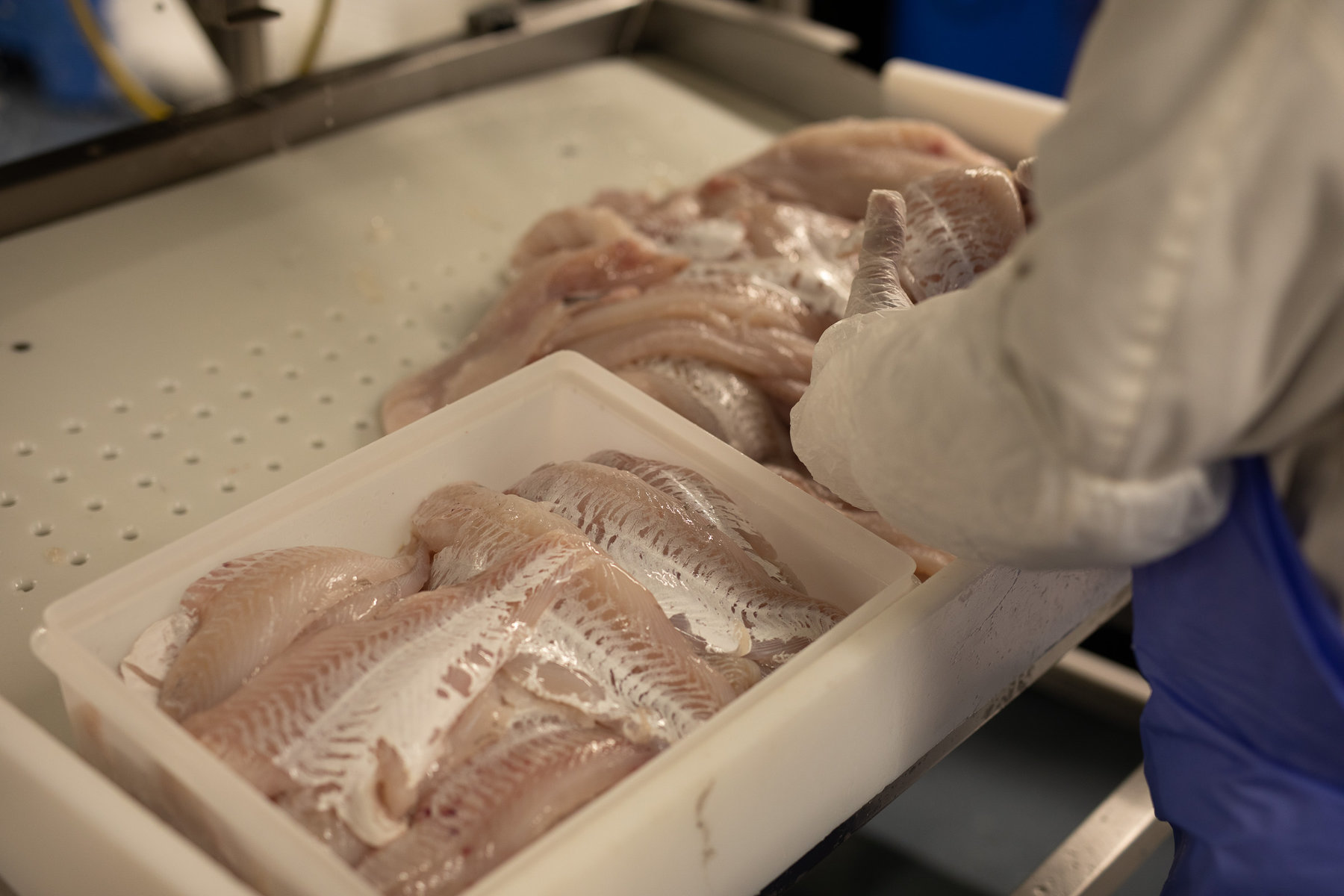 Haddock on its way to be donated to a food pantry. Credit: Scott Gable
Haddock on its way to be donated to a food pantry. Credit: Scott Gable
Part of that effort is confronting ideas we hold about eating fish, one of which is scarcity. “We tell the story about the decline of the groundfish fishery in Maine, and in New England, and a lot of that is attached to cod,” Martens says. While cod was indeed overfished in the 1990s and isn’t expected to recover to sustainable levels until 2030, there is growing evidence in the Gulf that other groundfish populations, like monkfish, pollock and grey sole, are stable. “One of the neat things about Maine fisheries that we can say with good conscience as an organization is that if it’s from Maine, it’s sustainable,” Olcott says. The domestic seafood industry is already highly regulated, but in the Gulf of Maine, there are additional factors that add to sustainability, particularly in the groundfish fleet: Businesses are independently owned and operated, which means a lot of fishermen end up in inadvertent roles as stewards of the fishery. They’re cognizant of the value of harvesting in sustainable ways, and many participate in electric monitoring and gear modification programs.
Amid this ongoing sustainability conversation, one of the bigger challenges FFM faces has also proven to be one of the program’s more replicable features: the purchase and supply of underutilized species. Identifying and developing markets for lesser-known types of fish is not only sustainable but positions fisheries everywhere to weather some of the more severe economic consequences of climate change. But selling people on trying unfamiliar fish comes with some hurdles. Most people are acquainted with cod, less so with pollock, hake and grey sole, even though these fish can all be substituted for most recipes calling for a flavorful, flaky fish.
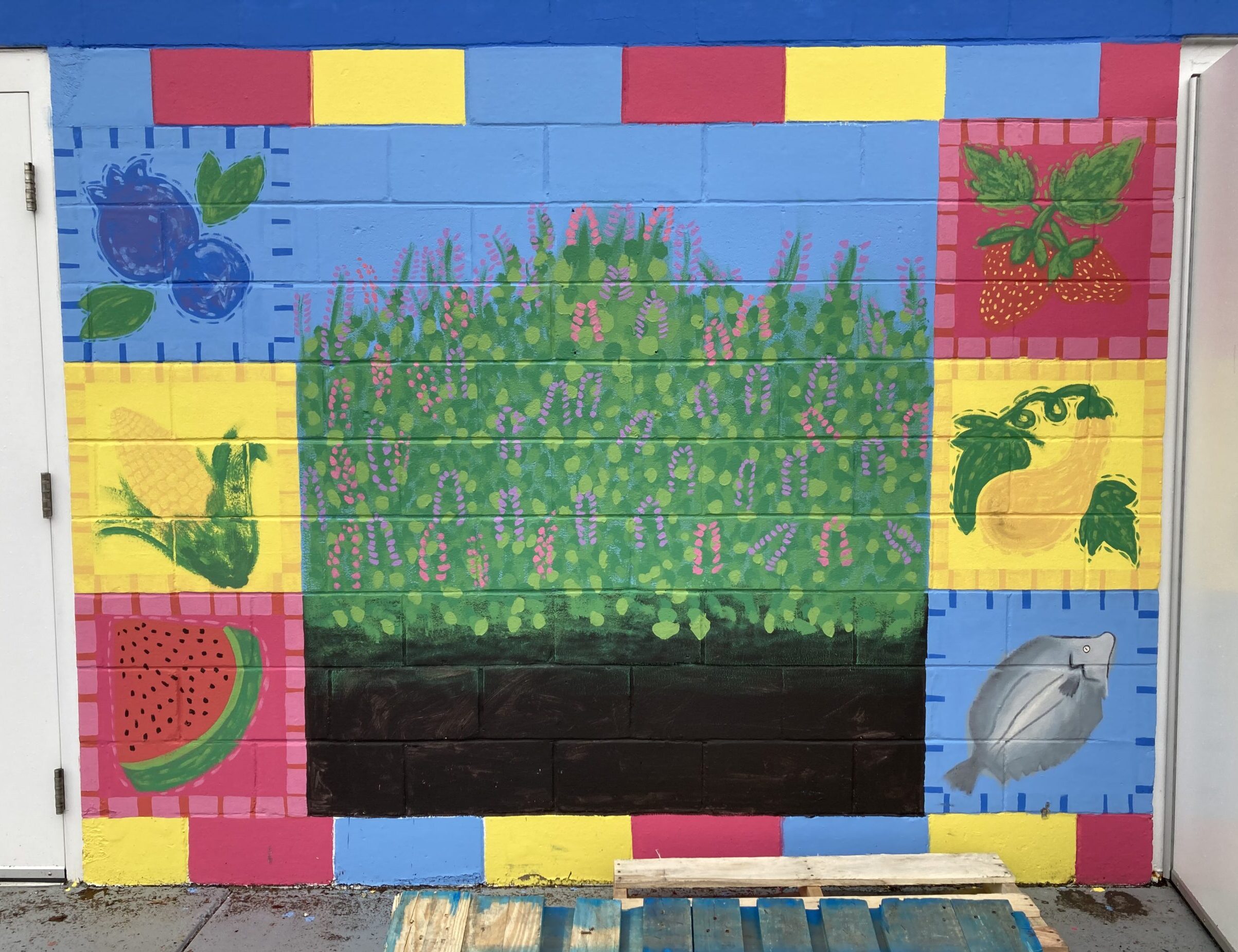 A mural at MaineHealth Food Pantry highlighting local and culturally important foods, including grey sole. Credit: Kea Krause
A mural at MaineHealth Food Pantry highlighting local and culturally important foods, including grey sole. Credit: Kea Krause
Expanding what can be considered culinary, which FFM tries to do with various types of outreach including developing and distributing their own value-added monkfish stew to regional grocers, is a type of messaging that could be adapted by other fisheries nationwide. “We are in a really interesting position where we can slowly start to rebuild those markets with fishermen landing more consistently,” says Olcott. And while perhaps it is a little harder to make people more adventurous about what species they’re eating, how they’re eating it, FFM is finding, is very consistent.
Though there is less of a market based on species, there is one for whole, intact fish. With their bones and skin, along with their meat, whole fish provide more nutrition and more flavor when cooked, and they can be used in a variety of preparations, as opposed to fish that have been processed down into filets and other cuts. At the MaineHealth Food Pantry at Maine Medical Center, a shopping-model food bank where visitors can browse shelves and coolers for food, groundfish from FFM has become a sustaining protein. “Because we’re a hospital-based food pantry, we have certain standards on the healthy food that we’re offering,” Rachel Freedman, the food pantry’s program manager, tells me. “And our focus along those lines is really on culturally important food.” Species of fish that turn flaky and white when cooked swim the oceans worldwide, which makes the groundfish donated by FFM especially important at the Food Pantry: They can be used to replicate just about any dish that calls for white fish, and they are also halal.
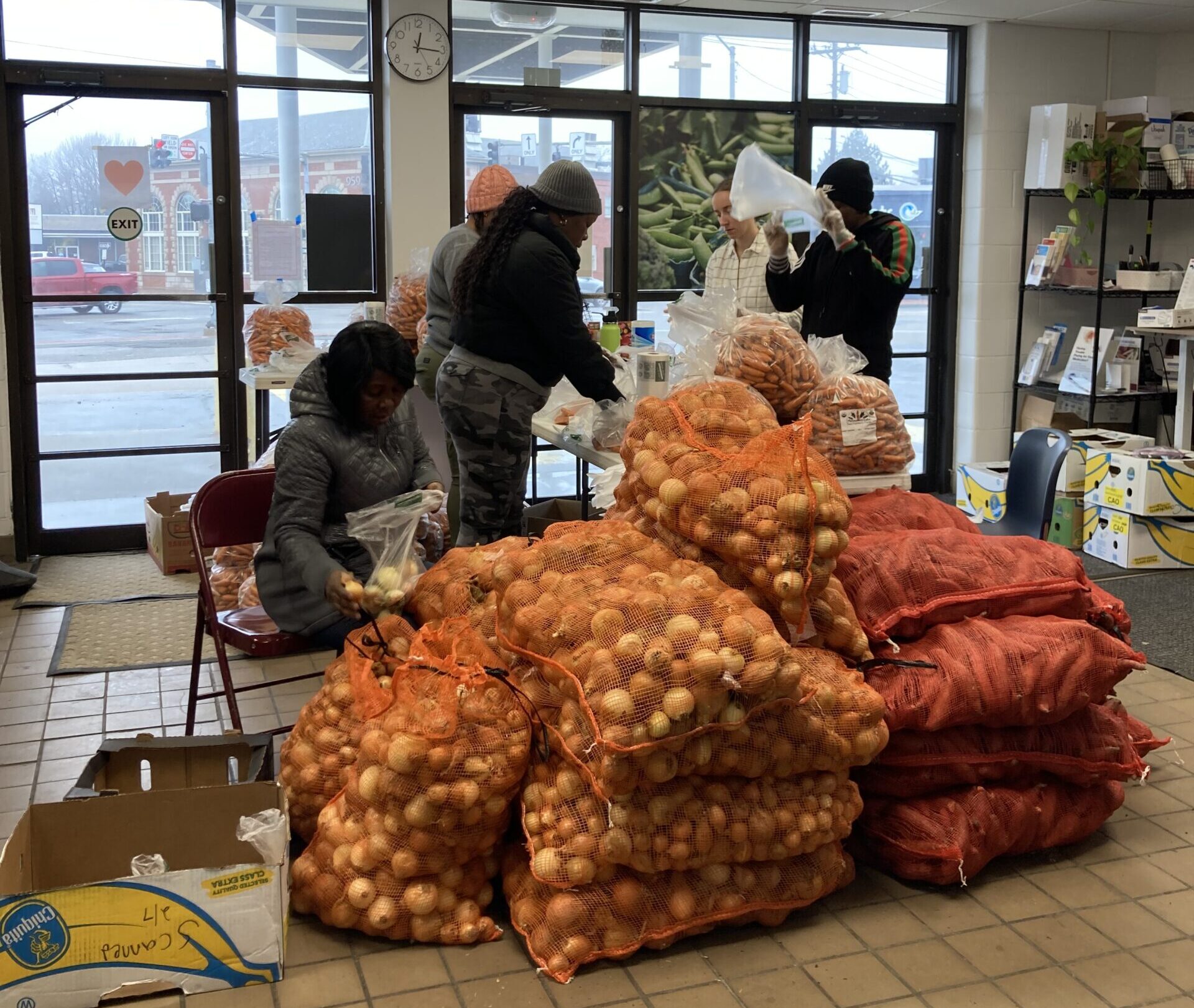 Volunteers at the MaineHealth Food Pantry at Maine Medical Center unload deliveries. Credit: Kea Krause
Volunteers at the MaineHealth Food Pantry at Maine Medical Center unload deliveries. Credit: Kea Krause
Located in Portland’s old Greyhound bus station, the Pantry distributes between 17,000 and 19,000 pounds of food a week to an average of 550 community members and their families. Many of the Pantry’s customers are new to Maine, and the United States more generally, with over 80 percent of visitors speaking French, Portuguese or Spanish as their primary language. With such a diverse clientele, the Pantry has “cultural brokers,” community members that help visitors navigate the space and the products that are available.
Though many of the Pantry’s products are novel to its community members, whole fish spans cultures and languages, and it has become one the Pantry’s most in demand items. “We have folks that are shopping who are from Southeast Asia, that’s what they want. We have folks who are shopping who are from Central Africa, that’s what they want,” says Freedman. “Across cultures, the whole fish is definitely the hottest ticket item.”
At the Pantry, visitors can find a variety of pamphlets and cookbooks by immigrant women living in Maine that offer local substitutions for recipes of their home countries where fish like tilapia is more common. “Some people come in and they’re like, ‘I just got here last week,’” Freedman says. “And some people are a little bit more established. But everyone’s kind of working on, ‘I’m used to this thing. What do we have here in Maine that I can still use in cooking that feels familiar and comfortable and important?’”
Credit: Kea Krause
The MaineHealth Food Pantry distributes between 17,000 and 19,000 pounds of food a week to an average of 550 community members and their families.
On a slick and windy day, the Pantry was in full swing, with volunteers dashing out to trucks and vans in the parking lot to unload the week’s donated goods, including fish from FFM. In all the activity, Nicole, a Congolese cultural broker, showed me pictures of a fish stew she cooked with some of the FFM fish. In addition to her cultural broker role, Nicole prepares culturally and traditionally important food for newly arrived families who are living in temporary housing — usually at a hotel — and do not have access to kitchens to cook themselves. The dish she showed me radiated warmth — it appeared to be bubbling away on a stove — its ingredients, like the fish, perhaps novel but nonetheless nourishing.
“As Maine becomes more diverse, it’s a neat opportunity for Maine seafood, kind of in both directions,” Olcott reflects on the program benefiting both the fishermen and underserved communities.
“It’s just a win-win,” says Vincent Balzano, a third-generation fisherman, who also is a part of the FFM program. “The program establishes a floor for official prices and also allows us to give back to the public.” Balzano still recalls some of the feedback he received when he first got involved with the FFM program and his catch was distributed among food banks. “About a week later, we received a heartfelt thank you from a woman — an elderly woman — that hadn’t eaten haddock in years because she couldn’t afford it,” he says. “I got a better return than I had been getting, the processor that processed the fish was able to keep their cutting room operating and keep their employees paid. And the end result was a woman was able to have a treat that she hadn’t had in years. For me, that really struck a chord.”
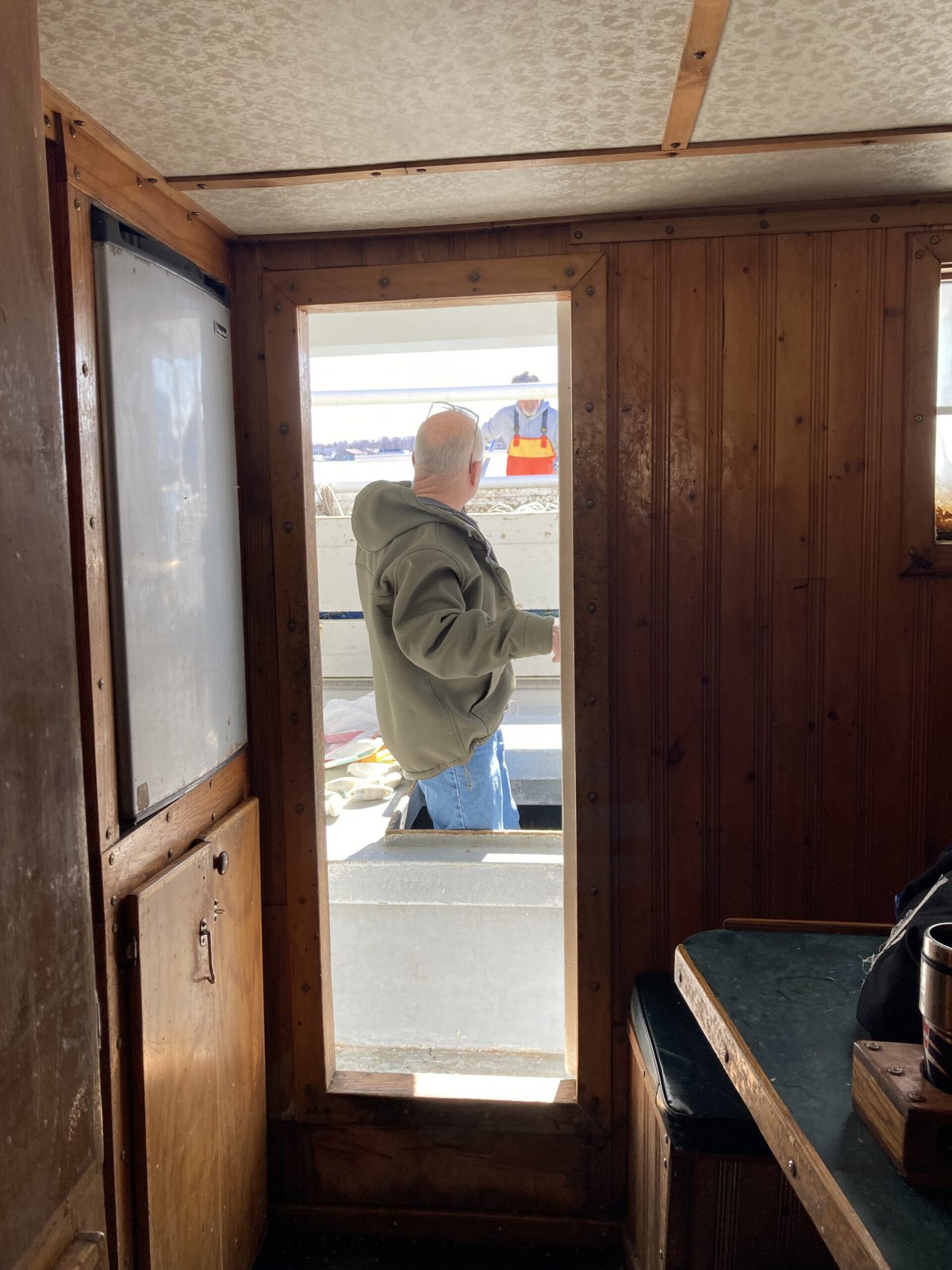 Geordie King on the Brittany Lynn. Credit: Kea Krause
Geordie King on the Brittany Lynn. Credit: Kea Krause
Back on the Brittany Lynn, King used the same phrase, win-win. As he puts it, the FFM program “takes the lows out of the lows” but also makes people feel good as fishermen. And he gets to keep doing what he loves, which is fishing. King missed it during the pandemic and misses it when he hasn’t been out in a while. “When you lose sight of land, it’s just a different world,” he says. “Not everything about fishing is rosy, but I do love the natural environment. Most fishermen will tell you that’s a big part of why they love it. We get to see whales, birds, porpoises. The beautiful blue seas and the stars. We see it all.”
And who wouldn’t want to experience a different world, one in which the role of uncertainty is diminished? For Martens, that added stability is what FFM’s work is all about. “For these people that live in some of the most disruptive times in history for their businesses — we’ve got climate change, we’ve got marketplaces that are all over the place, we’ve got regulations that are changing, we’ve got gentrification up or down our coast,” he notes. “These communities are changing faster than they probably ever have. All of these things are contributing to uncertainty. But there are places that we can bring a little bit of certainty back, a little stability back. And this program is one piece of that equation.”
The post How Unfamiliar Fish Are Helping Mainers Fight Food Insecurity appeared first on Reasons to be Cheerful.
What Does Reproductive Health Have to Do With Climate Vulnerability?
When Gufasha Moureen was 13 years old, a severe drought hit her village in the Kayunga district of Uganda. All her family’s crops were destroyed, sending them into a financial crisis.
Being the eldest daughter of five children, she had to leave school and help her mother at home with fetching water, cooking and childcare. One day, an elderly man visited their home and told Moureen’s father that he wanted to marry her.
Her father, who was in desperate need of money and saw no other option for Moureen, agreed. Moureen married, got pregnant and died the same year during a complicated childbirth.
 The Gufasha Girls Foundation works to educate girls about family planning. Credit: Joan Kembabazi
The Gufasha Girls Foundation works to educate girls about family planning. Credit: Joan Kembabazi
“That is just one of many devastating stories of how climate change affects young girls worldwide. Had the drought not hit her village, Moureen could have stayed at school and her life could have been different,” says Joan Kembabazi, Moureen’s best friend and founder of Gufasha Girls Foundation, a community-based nonprofit that advocates against child marriage and promotes girls’ education.
In Uganda, young girls and women face multiple challenges. Not only are they disproportionately affected by climate change but they also have limited access to modern contraceptive methods and have no comprehensive sexual and reproductive health education at schools (it was banned by the Parliament in 2016), which makes them even more vulnerable.
Kembabazi sees family planning as an essential tool for climate resilience. That’s why she’s committed to empowering girls and women with education and contraception. “I myself come from a big family and I know how hard it is for my father to provide for his 24 kids,” says the young Ugandan feminist activist. “If he had two or three, it would be much easier.”
Gufasha Girls Foundation is one of many organizations worldwide working to address the ways that poverty, food insecurity, climate change and family planning are linked — and the need to empower girls and women through education and family planning.
Healthy communities, healthy environment
In the Philippines, the PATH Foundation Philippines, Inc. (PFPI) has pioneered an approach that addresses population, health and the environment. When it started in the 1990s as a public health organization raising awareness about the prevention of HIV and AIDS, the foundation worked with young girls who moved to cities to work in the sex industry to support their families at home.
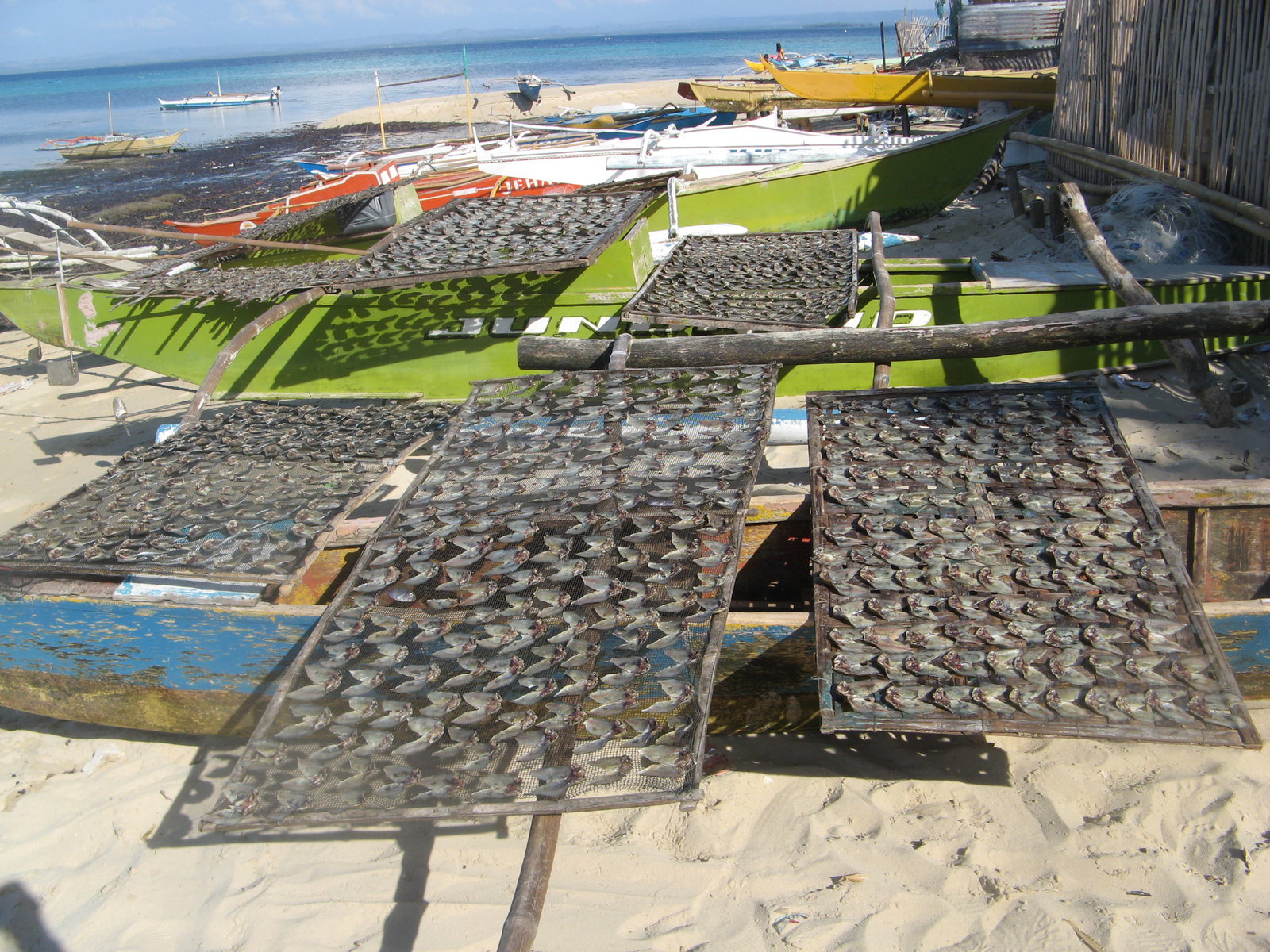 The PATH Foundation Philippines designated areas where fishermen could fish and areas where fishing was prohibited to give the fish stocks time to regenerate. Credit: Ellen Gallares
The PATH Foundation Philippines designated areas where fishermen could fish and areas where fishing was prohibited to give the fish stocks time to regenerate. Credit: Ellen Gallares
PFPI staff understood that if they wanted to help prevent young girls from contracting HIV, they would have to look at the root causes that led them to this line of work. They went to the poor fishing communities where the girls came from (namely the Danajon Bank and Verde Island Passage, which are extremely rich in marine biodiversity) and learned that fishermen there were facing pressure to catch more fish to sustain a growing population.
But since the fish stocks did not have time to regenerate, there were fewer fish every year. This meant that the families had less food and income and were more inclined to send their daughters away to contribute to the budget.
Between 2008 and 2013, PFPI worked with other organizations and the local community to improve the management of 2,000 hectares of marine protected areas. They designated areas where fishermen could fish and areas where fishing was prohibited to give the fish stocks time to regenerate.
Crushed by negative news?
Sign up for the Reasons to be Cheerful newsletter.
[contact-form-7]
Over the course of five years, the fish stocks increased and the food security and economic situation improved. The fishermen also started branching out into other ways to make money, such as selling produce from vegetable gardening, livestock and fowl keeping, running small businesses and tourism.
Besides sustainable management of resources, PFPI also addressed the health needs of the communities. In these isolated rural areas where access to contraceptives was limited to only a few health clinics, it partnered with small convenience stores that started selling condoms and birth control pills in every village.
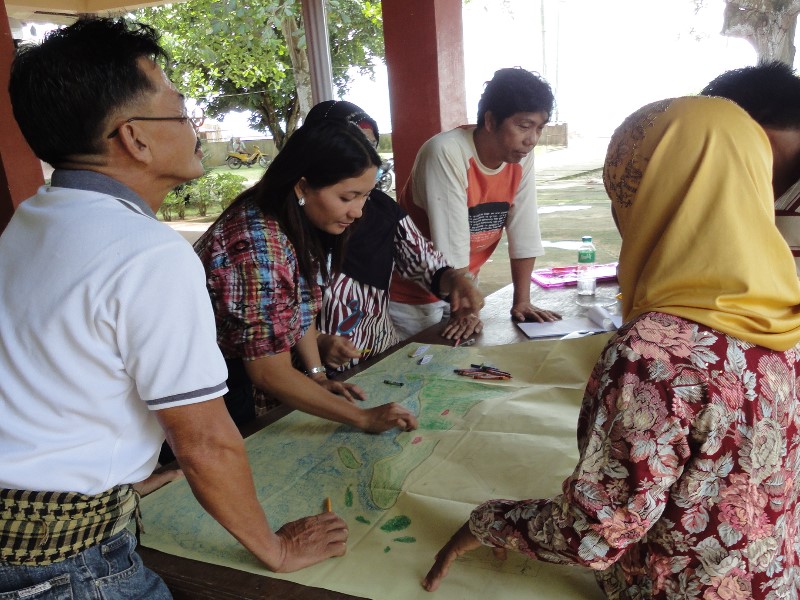 The PATH Foundation Philippines has pioneered an integrated approach that addresses population, health and the environment. Credit: PATH Foundation Philippines
The PATH Foundation Philippines has pioneered an integrated approach that addresses population, health and the environment. Credit: PATH Foundation Philippines
The foundation worked with local leaders — mainly youth, couples, women and fishermen — who then educated their peers about the benefits of family planning, HIV prevention, water and sanitation and malnutrition. Through these peer educators and educational shows on local TV and radio, PFPI was able to reach 1.5 million people. As a result, the rate of contraceptive use among married women of reproductive age increased from 31 percent to 45 percent.
Following its success in the Philippines, PFPI has been advocating for this integrated approach to address climate change, food insecurity and public health in other places in need around the world.
A lack of recognition
On the local level, this approach has been replicated in many parts of the world, including in Venezuela, Colombia, Madagascar, Uganda and Nepal). But on the national level, securing climate and gender justice is not always high on policy makers’ priorities.
At last year’s COP28 in Dubai, representation of women was staggeringly low: only 15 out of 133 world leaders present were women. “When it comes to decision-making power, you can’t make decisions that have the whole world in mind when half the population is not represented in the room,” says climate and community development expert Carissa Patrone Maikuri.
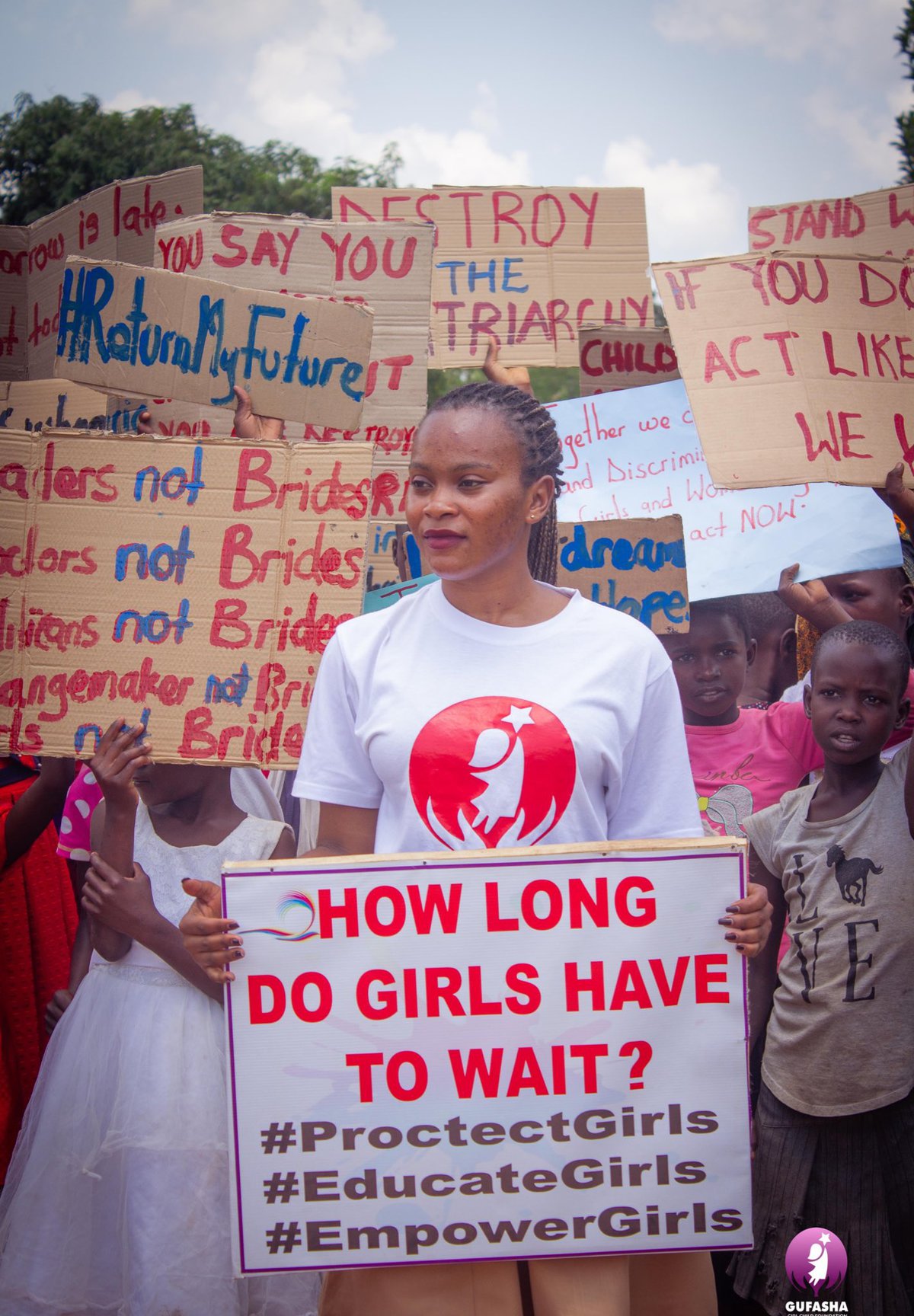 Young girls and women in Uganda have limited access to modern contraceptive methods and no comprehensive sexual and reproductive health education at schools. Credit: Joan Kembabazi
Young girls and women in Uganda have limited access to modern contraceptive methods and no comprehensive sexual and reproductive health education at schools. Credit: Joan Kembabazi
According to the Feminist Climate Justice report, by 2050, up to 158 million more girls and women might be pushed into poverty due to climate change. And yet, many countries’ adaptation plans still don’t mention sexual and reproductive health and rights or universal education as essential human rights or as important adaptation strategies.
Presently, more than 218 million women in low- and middle-income countries want to avoid pregnancy but are not using a modern method of contraception. Globally, nearly half of all pregnancies are unintended.
Turning the tide
It makes sense that, when women are able to choose whether, when, with whom, or how many children to have, they can further pursue their education, tend to have better access to work opportunities, and can improve their own health and that of their families. But the connection to climate change can be harder for people to make.
Patrone Maikuri is among those working to spread the message that family planning can boost women’s resilience to environmental and climatic shocks and stressors. “Many climate folks don’t understand how sexual and reproductive health and rights [are] connected to climate resilience, and as a result, they shy away from the conversation,” she says. “But in the past few years, there has been a small movement that is looking at climate action in a more holistic and intersectional way.”


Become a sustaining member today!
Join the Reasons to be Cheerful community by supporting our nonprofit publication and giving what you can.
A growing number of international organizations have been advocating for gender equality and women’s and girls’ reproductive rights to be embedded into climate solutions and climate justice. For example, the Intergovernmental Panel on Climate Change highlighted voluntary and rights-based family planning as a climate adaptation strategy in its 2014 assessment report. And in 2023, the UN Women called for a new feminist climate justice approach.
The tide is turning, according to Carina Hirsch, head of advocacy and policy at the nonprofit Margaret Pyke Trust. She points to the growing alliance of health-focused organizations that are advocating at a national level with both climate and conservation sectors as well as growing interest from donors to fund this kind of work.
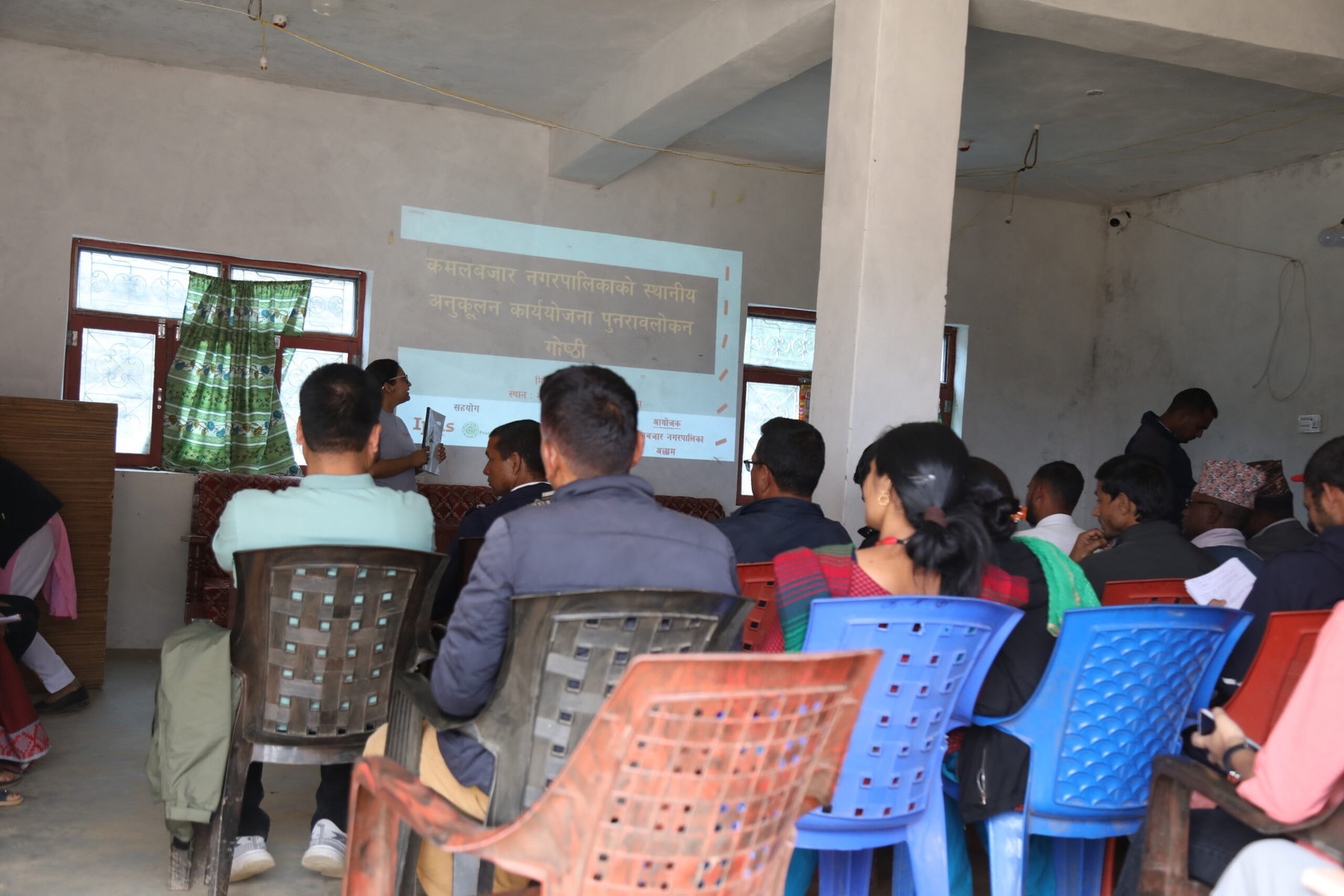 A Local Adaptation Plan of action review workshop in Nepal. Credit: Ipas Nepal
A Local Adaptation Plan of action review workshop in Nepal. Credit: Ipas Nepal
For her, one of the most exciting recent developments was the announcement at COP28 that the UK will provide £16 million in funding focused on the importance of reproductive choice as part of climate resilience building.
Khusbu Poudel, the program coordinator at reproductive rights nonprofit Ipas Nepal, sees this as a welcome change. Nepal is one of the most climate vulnerable countries in the world, and Ipas Nepal helped local governments prepare Local Adaptation Plans for Action, which integrate gender, climate and sexual and reproductive health and rights. “Investing in women, children and adolescents is one of the most impactful climate actions a country can make,” says Poudel, who participated at COP28.
The urgency, Hirsch notes, is clear: “We cannot wait. Climate change is coming no matter what and we know it,” she says. “The least we can do is to make people, particularly women and girls in remote rural communities, that are being hit hardest by climate change, more resilient.”
The post What Does Reproductive Health Have to Do With Climate Vulnerability? appeared first on Reasons to be Cheerful.
Come for the Free Meals, Stay for the Company
Brandon, Jackie and Julie meet for dinner every Thursday, sitting at their regular table, and often going out afterwards to a pub quiz nearby. They talk about possible quiz topics and whether they can beat their previous performance, as they dine on a freshly prepared three course meal. Servers in black aprons swiftly bring them warm bowls of freshly made butternut squash soup, hearty vegetable cottage pie, and apple crumble covered in steaming custard, a perfect antidote to a cold evening.
As they leave, there’s no check to pay for this generous meal. The pop-up cafe at a church hall in Chelmsford, England is one of 80 held across the country throughout the week. They’re an initiative of FoodCycle, the UK’s largest community dining organization, which turns produce that supermarkets would otherwise throw out into a free meal for anyone who wants to attend. In 2022, FoodCycle’s pop-up cafes served nearly 500,000 meals to 62 communities across the UK, saving 209 tonnes of food from going to waste.
It might be a small dent in the 9.5 million tonnes of food waste the UK as a whole throws out each year, but FoodCycle’s impact is much bigger than this. Forty-three percent of people who attend FoodCycle meals, like Jackie and Julie, live on their own, with 68 percent of them feeling lonely, according to a survey of 910 FoodCycle guests in 2022. Loneliness is considered to be a significant mental and public health issue in the country, affecting over half the population, with the Mental Health Foundation linking it to depression and declining physical health.
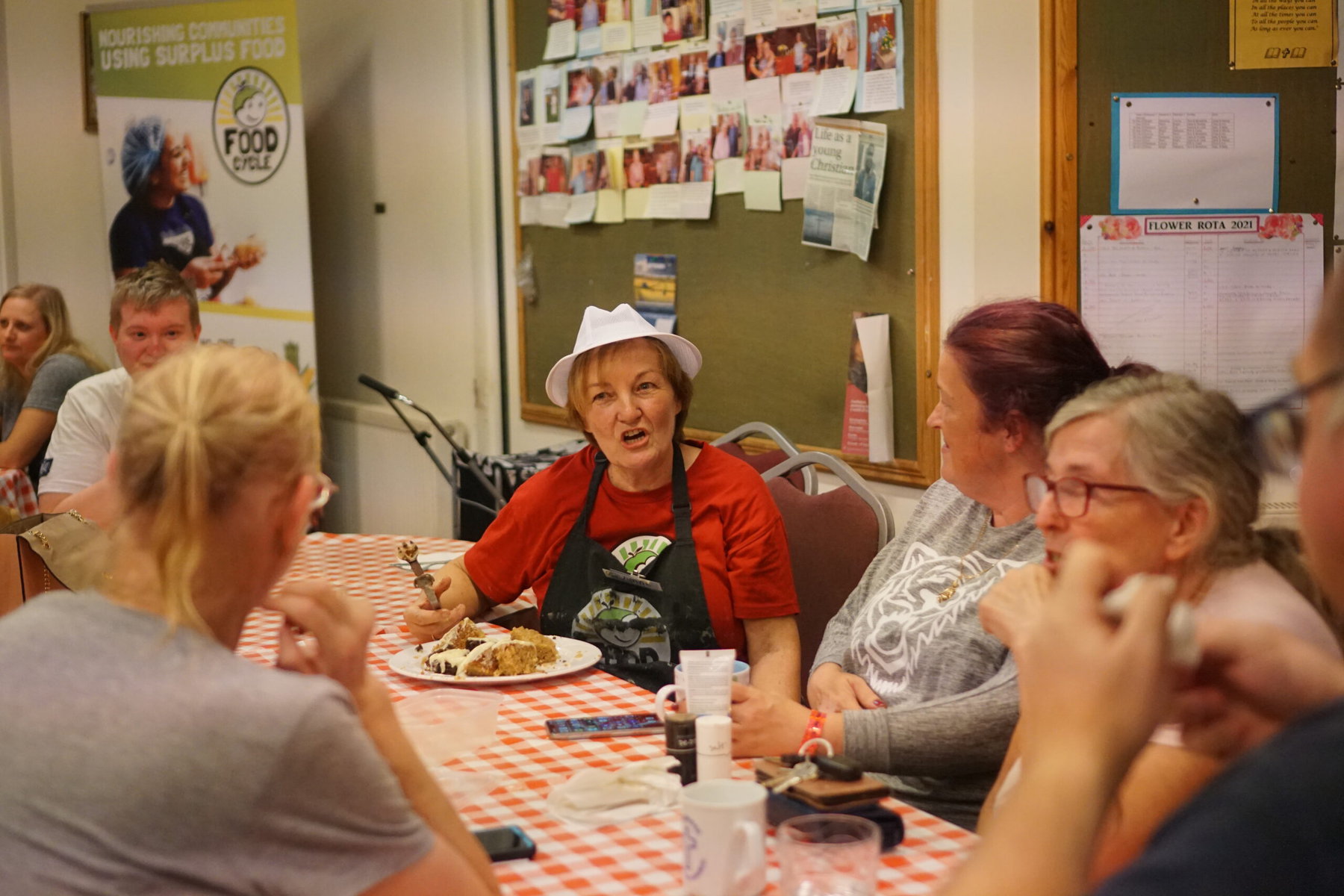 “Being able to sit in a warm and very friendly environment, whilst having hot drinks and amazing food is wonderful,” one attendee told FoodCycle. Credit: FoodCycle
“Being able to sit in a warm and very friendly environment, whilst having hot drinks and amazing food is wonderful,” one attendee told FoodCycle. Credit: FoodCycle
Food poverty is FoodCycle’s third reason for being. Around 4.7 million people in the UK, or seven percent of the population, are considered to be in food poverty — defined by the government as not being able to secure “an adequate quality or sufficient quantity of food in socially acceptable ways.” Sixty-eight percent of FoodCycle guests worry about affording food, and 92 percent are concerned about the increasing price of food, to the extent that 75 percent regularly skip meals.
“These issues are intertwined and interlinked. We know there’s a correlation between people who are facing food poverty, and feeling isolated and disconnected from their communities,” says Sophie Tebbetts, FoodCycle’s head of programs and incoming CEO from January 2024.
Crushed by negative news?
Sign up for the Reasons to be Cheerful newsletter.
[contact-form-7]
And the need, Tebbetts says, is only growing: “We’ve really seen over the last couple of years in particular the cost of living impacting our guests — we have just reached over 100,000 community meals so far this year, and we’re definitely seeing guest numbers rising across our locations and the need becoming larger.”
As a result, FoodCycle plans to expand to 100 weekly community meals in the next year, and is on a drive to boost its 6,000-strong volunteer base of cooks and servers. Some of its most well-attended meals serve up to 80 guests, making it a challenge each week for volunteers to devise a nutritious, tasty, well-rounded meal from donated supermarket produce that they will only get their hands on three hours before dinner service begins.
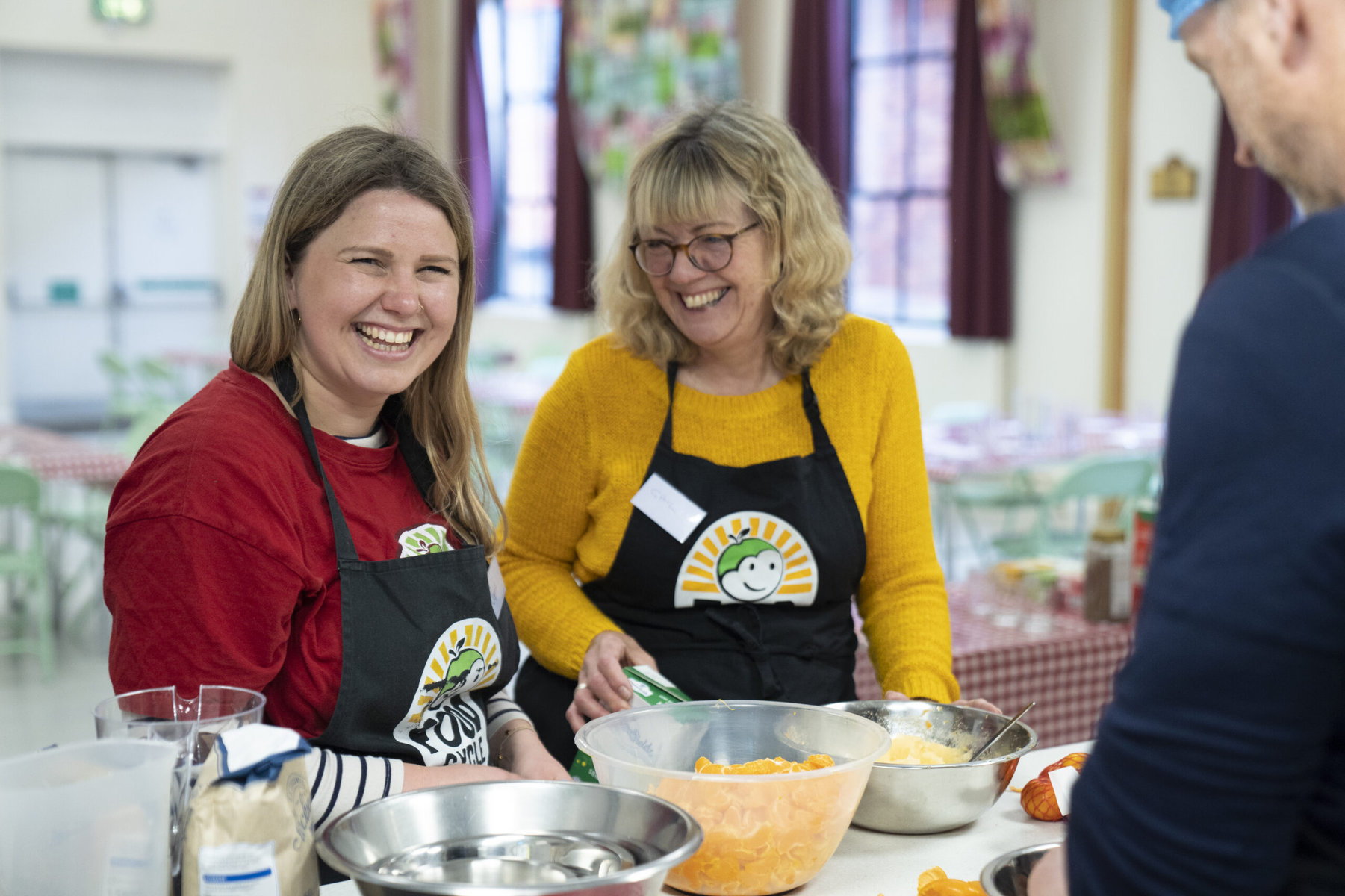 Sophie Tebbetts and a volunteer preparing custard. Credit: FoodCycle
Sophie Tebbetts and a volunteer preparing custard. Credit: FoodCycle
For many families that attend, it’s their weekly meal out as they can’t afford to go to a restaurant. During the school vacation period, it’s a lifeline for those whose children would otherwise have their single hot meal of the day at school under the government’s Free School Meals program. “It’s amazing how it is 2023 and we have that stark situation for so many people,” says Tebbetts.
The majority of FoodCycle’s weekly community meals are open to anyone, a factor which Tebbetts believes is more important than it might seem.
“Life is difficult for a lot of people. There’s a lot of stuff going on. What we want to do is create safe, warm, welcoming spaces where people can just come and connect with each other. They don’t have to prove they are in need of a free meal,” she says. “If you are struggling and are feeling isolated financially, or with your mental health, there are a lot of things you have to prove in terms of accessing help. We want to remove all of that.”
There are, however, three FoodCycle locations that have been designed for specific demographics and are open only to those groups. In Acton, West London, and Dalston, East London, weekly meals run exclusively for refugee mothers and their children, while in Stepney Green, East London, a meal is held for people living with HIV.
“Often when refugees are housed, they don’t have space for tables to sit down and eat at. So to create spaces where they can sit with others and share a meal is really important,” says Tebbetts.
Nutrition, Tebbetts notes, is really important for the health of those living with HIV: “Around 40 percent of our guests have long-term health conditions, so their diet is key to maintaining a healthy lifestyle. We also know that if you’re on a low income, you actually can’t afford to purchase what the government recommends as a nutritious meal in its Eat Well guide. We pack our meals full of fresh fruit and veggies to help up their nutritional intake during the week.”
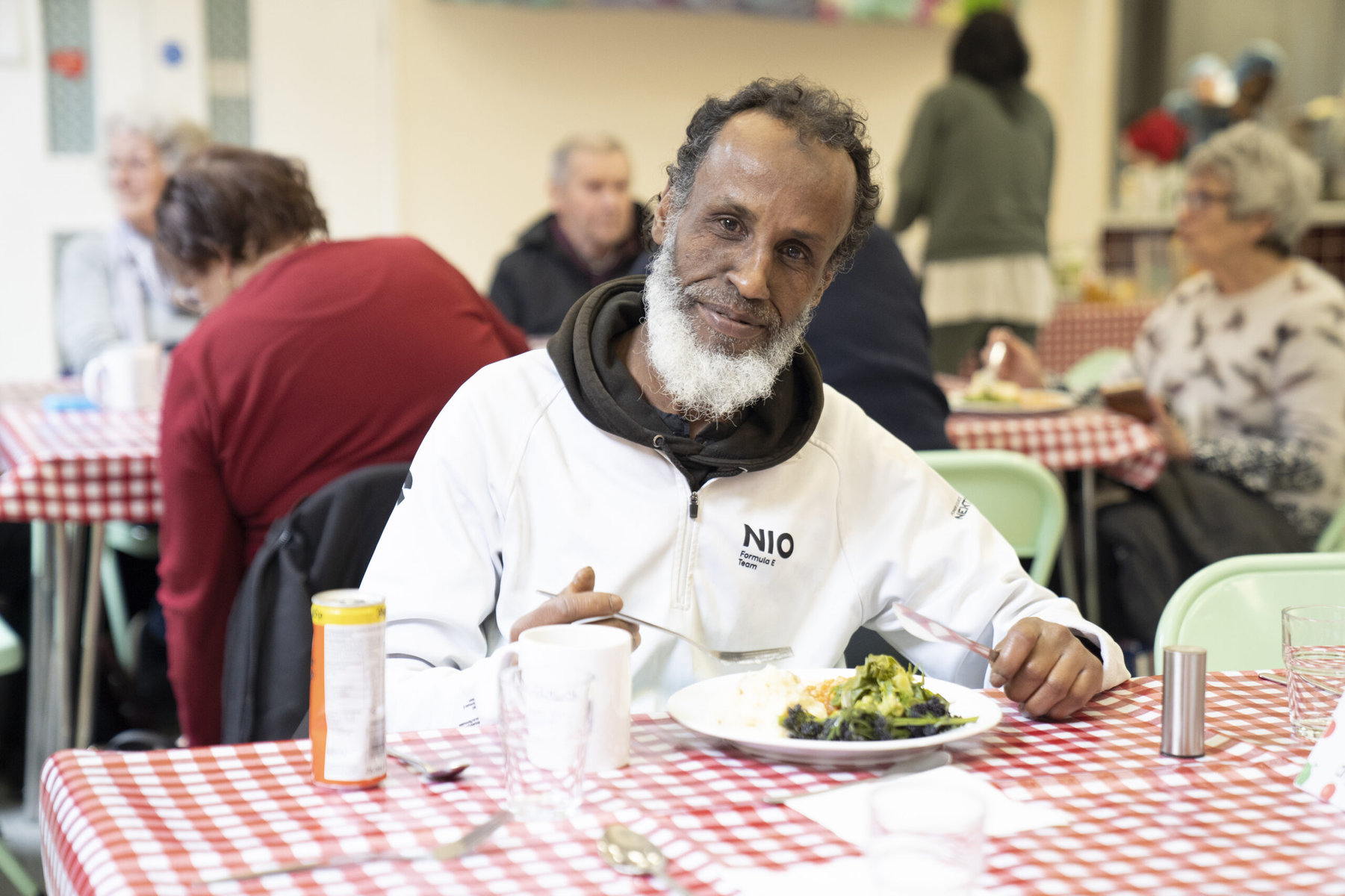 FoodCycle makes sure to pack its meals with fruits and vegetables. Credit: FoodCycle
FoodCycle makes sure to pack its meals with fruits and vegetables. Credit: FoodCycle
How the rising cost of living is impacting FoodCycle itself is not lost on Tebbetts. Venues — typically church halls or community centers, as they are most likely to have the space and kitchen facilities — are facing their own financial pressures and are becoming more reluctant to offer their spaces for free. For supermarkets, of course, it’s a no-brainer to donate produce that would otherwise be wasted, but FoodCycle still needs to purchase ingredients like herbs, spices, eggs, cheese and pasta to stock its “pantry” to turn those donations into proper meals (all vegetarian, for health, safety and inclusivity reasons).
That’s where corporate partners come in, making up over 40 percent of the £1.8 million (around $2.2 million) in income FoodCycle generated last year to cover its operating costs. Companies like Goldman Sachs have even taken part in FoodCycle Food Invention challenges, with teams creating meals from donated produce to donate to communities in need.
The difference being made is clear. Eighty-one percent of FoodCycle guests in the 2022 survey said they felt less lonely since attending their community meal, and 90 percent said they felt well-fed. Andrew, for example, lives on his own and is unemployed, living off just £14 (around $17) a week for food. “Over and above the food side of it, I like the companionship of meeting people socially and having a chat because most weeks I don’t see anybody. From the social aspect it is very warming,” he told FoodCycle.


Become a sustaining member today!
Join the Reasons to be Cheerful community by supporting our nonprofit publication and giving what you can.
Pensioner Sylvia, meanwhile, takes three buses over an hour and a half journey to get to her local FoodCycle meal, giving her a reason to leave the house, and easing her decision to turn on her heating or buy food. And for Diane, whose rising bills have impacted her mental health, and who often struggles to get out due to mobility issues, a regular FoodCycle community meal is something to look forward to.
“Being able to sit in a warm and very friendly environment, whilst having hot drinks and amazing food is wonderful,” she told FoodCycle.
As a community dining initiative above all, Tebbetts says FoodCycle is different from other charities, which often say their ambition is to one day not exist. “Even if we solved hunger, food waste and loneliness, we still think there should be spaces where people can gather and connect,” she says.
The post Come for the Free Meals, Stay for the Company appeared first on Reasons to be Cheerful.